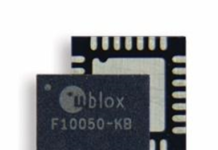
Ricoh’s latest 360-degree camera model, the THETA X, comes equipped with the miniature low-power u-blox GNSS module ZOE-M8B, that delivers long-lasting, dependable GNSS performance for small battery-powered devices
u-blox has announced the integration of its ZOE-M8B GNSS (global navigation satellite system) module into the new RICOH THETA X. Ricohs’ latest camera, the first of its kind, allows users to shoot high-quality 360-degree spherical images and videos in just one click and to visual them immediately on a large LCD touch panel.
u-blox GNSS Module-ZOE-M8B
The u-blox GNSS Module-ZOE-M8B enables the RICOH THETA X’s built-in GPS, one of its key new features. The GPS (QZSS) and A-GPS automatically embed highly accurate location information to each image taken without the need for a smartphone or another external device. An icon on the LCD touch panel displays the availability of the GPS signals depending on the user’s location, ensuring that the location information has been reliably acquired before starting shooting. This new function makes the THETA X the most location accurate camera on the market, down to a 5m radius, and is therefore ideal for a wide range of industrial and consumer applications. It is for instance a must-have tool for construction and architecture professionals – who can digitize sites through 360-degree scenery imagery and capture any project phase – but also for the mapping industry, insurance providers, realtors, etc.
The u-blox GNSS Module-ZOE-M8B is a ultra-small (4.5 x 4.5 x 1.0 mm) SiP (System-in-Package) GNSS module offering highly accurate positioning with concurrent reception of up to 3 satellite constellations. The Super-E (Super-Efficient) mode guarantees power consumption as low as 12 mW, and built-in SAW and LNA make it ideal for passive antennas. The u-blox ZOE-M8B targets applications that require a small size without compromising performance.
“We chose to integrate the u-blox ZOE-M8B GNSS module into our THETA X because of the highly accurate location information it offers, alongside easy integration thanks to its small size, and low power consumption. In other words, the module offers what we needed in terms of a small antenna design whilst not compromising on highly accurate positioning performance – a function essential to our customers,” says Mr. Kenji Daigo, GPS Function Developer for THETA X at Ricoh.



















